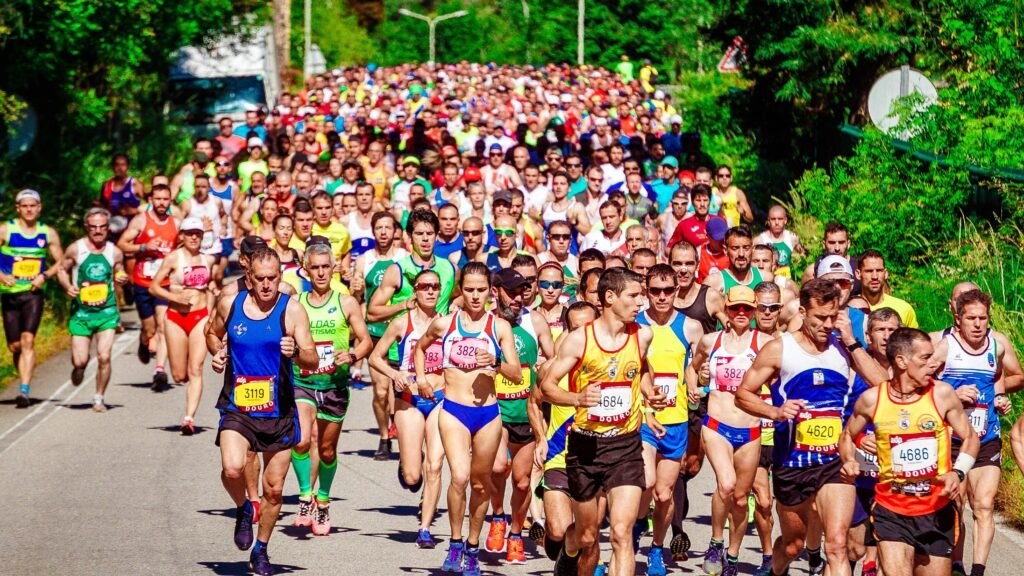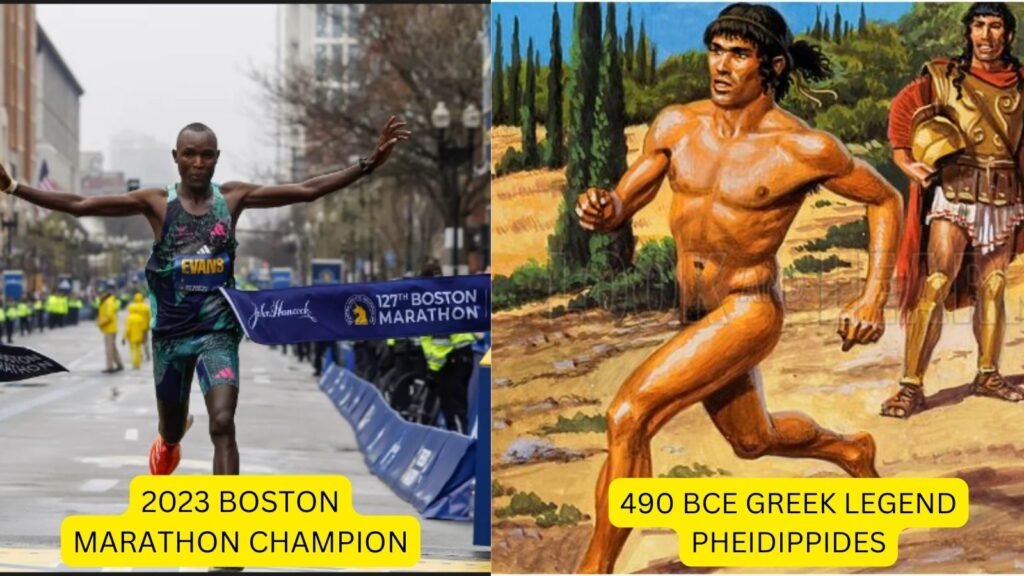Running a marathon is more than just covering a distance of 26.2 miles or 42.2 Km. It’s an epic journey that challenges the body, mind, and spirit. Whether you’re a seasoned marathoner or someone contemplating their first race, the marathon represents a test of endurance, determination, and the pursuit of personal triumph. Let’s dive into this epic chapter of running and explore what makes the marathon such a compelling and transformative experience.

💁History of the Marathon
Often wonder about why marathon run is 26.2 Miles but not the 25 miles neither 27 miles? To know about this answer you need to dive into the epic ancient history of Marathon! The marathon’s ancient history is steeped in legend, with its roots in the classical world of ancient Greece. The story of the marathon originates from a significant event during the Greco-Persian Wars and centers around a legendary long-distance run that has captured imaginations for centuries.
The Battle of Marathon
The foundation of the marathon myth is the Battle of Marathon, which took place in 490 BCE. This pivotal battle was fought between the forces of Athens, aided by Plataea, and the invading Persian army led by King Darius I the Most powerful king in that time. The Athenians, vastly outnumbered, managed to secure a decisive victory against the Persians on the plain of Marathon, approximately 26 miles northeast of Athens.
The Legend of Pheidippides
According to the popular legend, the Athenian general Miltiades sent a messenger named Pheidippides to run from the battlefield of Marathon to Athens to announce the victory. Pheidippides is said to have run the entire distance without stopping, burst into the Athenian assembly, and exclaimed “Nenikēkamen!” or “Nike!” (“We have won! -in Greeks”), before collapsing and dying from exhaustion.
This tale of Pheidippides’ run was recorded by later historians and has become an enduring part of the lore surrounding the marathon. However, it is worth noting that the earliest accounts, such as those by the historian Herodotus, do not mention this specific run. Herodotus does mention Pheidippides (or Philippides) in the context of another epic run: from Athens to Sparta, a distance of about 240 kilometers (approximately 150 miles), to seek Spartan assistance before the Battle of Marathon.
Historical Interpretation and Myth
The story of Pheidippides’ run from Marathon to Athens is widely regarded as a blend of myth and history. While there is no contemporary evidence confirming the precise details of this run, the legend has nonetheless inspired the modern marathon race. The tale symbolizes the extraordinary endurance and determination of the human spirit, qualities that are celebrated in the marathon today.
The Cultural and Symbolic Significance
In ancient Greek culture, running held significant importance, often featured in religious festivals and athletic competitions such as the Olympic Games. The legend of Pheidippides and the Battle of Marathon exemplified the ideal of the citizen-soldier, someone who was not only a warrior but also a messenger of vital news, embodying the virtues of courage, sacrifice, and dedication to the polis (city-state).
The symbolism of the marathon also extends to themes of victory and deliverance. The victory at Marathon was seen as a pivotal moment for the nascent democracy of Athens, ensuring its survival and future prosperity. The marathon, therefore, carries a legacy of triumph against overwhelming odds.
Modern History of the Marathon
The modern history of the marathon is marked by its evolution from a symbolic event rooted in ancient mythology to a globally recognized athletic competition that attracts thousands of participants each year. This journey includes significant milestones, cultural shifts, and the rise of marathon running as both a competitive sport and a popular recreational activity.
Revival in the Modern Olympics
The marathon as a competitive sport was revived in the late 19th century, inspired by the ancient Greek legend of Pheidippides’ run from Marathon to Athens. The idea to include a long-distance race in the first modern Olympic Games held in Athens in 1896 was proposed by Michel Bréal, a French philologist. The organizers embraced this suggestion, and the marathon became one of the original events of the modern Olympic Games.
The First Modern Marathon
The inaugural modern marathon took place on April 10, 1896, during the Athens Olympics. The course retraced the legendary route from the Marathon Bridge to the Olympic Stadium in Athens, covering approximately 40 kilometers (about 25 miles). Greek runner Spyridon Louis emerged victorious, capturing the imagination of the nation and solidifying the marathon’s place in Olympic history.
Standardization of Distance
The official marathon distance of 42.195 kilometers (26.219 miles) was established at the 1908 London Olympics. The race was extended by an additional 385 yards (352 meters) so that it could finish in front of the royal box at White City Stadium. This standardized distance was later adopted by the International Amateur Athletic Federation (IAAF) in 1921 and has since become the universally recognized length of the marathon.
Growth and Popularity
Throughout the 20th century, the popularity of the marathon grew steadily. Major marathons like the Boston Marathon (established in 1897), New York City Marathon (first held in 1970), and London Marathon (inaugurated in 1981) became iconic events that attracted elite athletes and recreational runners alike. These races not only showcased athletic prowess but also celebrated the spirit of endurance and community.
Women in the Marathon
For much of its early history, the marathon was exclusively a male domain. Women were initially prohibited from competing in the Olympic marathon, with the first official women’s marathon held in the Olympic Games occurring only in 1984 in Los Angeles. Joan Benoit of the United States won the inaugural women’s Olympic marathon, marking a significant milestone for gender equality in sports and paving the way for future generations of female marathoners.
Modern-Day Marathons
In the 21st century, the marathon has become more inclusive and diverse than ever before. Marathons are held in cities around the world, attracting participants of all ages, backgrounds, and abilities. Social media and digital platforms have further contributed to the marathon’s popularity, enabling runners to share their training experiences, connect with fellow enthusiasts, and inspire others to take up the challenge.
Charity and Social Impact
Many modern marathons are organized not only as competitive races but also as fundraising events for charitable causes. Runners often participate to raise awareness and funds for issues ranging from health and education to environmental conservation and social justice. The marathon has thus evolved into a platform for social impact, empowering individuals and communities to make a difference through physical activity and collective action.

💁Different Types of Modern Marathon Competitions
Marathons have evolved beyond the traditional 26.2-mile race, encompassing a variety of formats that cater to diverse interests, abilities, and challenges. From iconic city marathons to themed races and extreme endurance events, modern marathon competitions offer something for every runner seeking to push their limits and embrace the thrill of long-distance running. Let’s explore some of the different types of modern marathon competitions that have captured the imagination of runners worldwide.
1. City Marathons
City marathons are among the most popular and iconic marathon competitions globally, attracting elite athletes, recreational runners, and spectators alike. These races typically take place on urban streets, showcasing iconic landmarks, cultural attractions, and vibrant cityscapes along the course. Events like the Boston Marathon, New York City Marathon, London Marathon, and Tokyo Marathon are renowned for their rich history, competitive fields, and festive atmospheres that unite communities and celebrate the spirit of running.
2. Major World Marathon Majors
The World Marathon Majors (WMM) series comprises six prestigious city marathons held annually in major international cities. These marathons include:
- Boston Marathon: The Boston Marathon holds a special place in the hearts of runners worldwide as one of the oldest and most prestigious marathons. Established in 1897, it is renowned for its challenging course, historic significance, and enthusiastic crowds. Held annually on Patriots’ Day in April, the race attracts elite athletes, qualified runners, and charity participants from around the globe. The iconic “Heartbreak Hill” and the finish line on Boylston Street are symbols of determination and triumph for runners striving to conquer the 26.2-mile course. The Boston Marathon embodies the spirit of resilience, community support, and athletic achievement, making it a cherished event in the world of long-distance running.
- London Marathon: The London Marathon is a premier international marathon held annually in the vibrant city of London, England. Established in 1981, it has grown to become one of the largest and most iconic marathons in the world. The race attracts elite runners, charity fundraisers, and recreational participants from diverse backgrounds, all united in their passion for running and charitable causes. The scenic course winds through famous landmarks such as the Tower Bridge, Buckingham Palace, and the River Thames, offering participants a unique tour of London’s rich history and culture. Known for its festive atmosphere, enthusiastic crowds, and top-notch organization, the London Marathon embodies the spirit of endurance, community support, and celebration of human achievement.
- Berlin Marathon: The Berlin Marathon is renowned for its reputation as one of the fastest and most prestigious marathons in the world. Established in 1974, this annual race attracts elite athletes and recreational runners alike to the streets of Berlin, Germany. The flat and fast course, which often leads to world record-breaking performances, showcases iconic landmarks such as the Brandenburg Gate and Berlin Cathedral. Runners from around the globe gather to experience the vibrant atmosphere and historical backdrop of Berlin while pushing their limits over the 26.2-mile distance. The Berlin Marathon is celebrated for its impeccable organization, enthusiastic spectators, and the opportunity it provides for runners to achieve personal bests and celebrate their love for running in a dynamic and inspiring setting.
- Chicago Marathon: The Chicago Marathon is one of the six World Marathon Majors, held annually in the bustling city of Chicago, Illinois. Established in 1977, it has grown into one of the largest and most renowned marathons globally, attracting elite athletes, recreational runners, and spectators from around the world. The flat and fast course takes participants through diverse neighborhoods, iconic landmarks such as Grant Park and the Magnificent Mile, and along the shores of Lake Michigan. Known for its supportive crowds, energetic atmosphere, and top-tier organization, the Chicago Marathon offers runners a chance to achieve personal bests and experience the vibrant spirit of the Windy City while celebrating the thrill of long-distance running.
- New York City Marathon: The New York City Marathon is a legendary event that captures the essence of endurance, diversity, and community spirit. Established in 1970, it has grown to become the largest marathon in the world, attracting over 50,000 runners annually from across the globe. The marathon course spans through all five boroughs of New York City, starting in Staten Island and finishing in Central Park, Manhattan. Runners traverse iconic landmarks such as the Verrazzano-Narrows Bridge, Fifth Avenue, and Times Square, cheered on by millions of enthusiastic spectators lining the streets. Known for its challenging course, diverse participants, and unmatched energy, the New York City Marathon is a celebration of human achievement, unity, and the enduring spirit of the city that never sleeps.
- Tokyo Marathon: The Tokyo Marathon is a prestigious international race held annually in Japan’s bustling capital city. Established in 2007, it has quickly risen to prominence as one of the six World Marathon Majors, attracting elite runners and enthusiasts alike from around the world. The marathon course showcases Tokyo’s modern skyline, historic landmarks like the Imperial Palace, and vibrant neighborhoods, offering participants a dynamic and culturally rich running experience. Known for its efficient organization, enthusiastic crowds, and the blending of traditional Japanese hospitality with cutting-edge technology, the Tokyo Marathon embodies the spirit of endurance, innovation, and international camaraderie.
These marathons attract elite runners vying for championship titles and offer coveted opportunities for age-group qualifiers and charity entries, embodying the pinnacle of marathon competition.
3. Trail Marathons
Trail marathons take runners off the beaten path and into natural landscapes, challenging participants with rugged terrain, elevation changes, and scenic vistas. These races appeal to trail running enthusiasts seeking adventure and a connection to nature. Trail marathons vary in difficulty, from beginner-friendly courses to extreme ultra-marathon distances that test endurance over mountainous terrain and remote wilderness areas. Events like the Western States Endurance Run and Ultra-Trail du Mont-Blanc showcase the physical and mental challenges of trail running, attracting elite athletes and adventurous runners from around the globe.
4. Virtual Marathons
Virtual marathons have surged in popularity, offering flexibility and accessibility to runners of all levels who can participate from anywhere in the world. Participants complete the marathon distance on their own schedule, choosing their route and recording their time using GPS tracking devices or virtual platforms. Virtual marathons often feature themed challenges, charitable causes, and community support through online forums and social media. These events provide opportunities for individuals to set personal goals, stay motivated, and connect with a global community of runners while enjoying the convenience of running in their local environment.
5. Night Marathons
Night marathons add a unique twist to traditional marathon competitions by taking place after sunset, under the glow of city lights or starlit skies. These races offer a captivating experience for runners, with illuminated courses, festive atmospheres, and special entertainment along the route. Night marathons often feature themed costumes, glow-in-the-dark accessories, and after-party celebrations that create a memorable and exhilarating running experience. Events like the Midnight Sun Marathon in Norway and the Dubai Marathon Night Race exemplify the allure of running under the cover of darkness and experiencing a city’s nightlife from a runner’s perspective.
6. Adventure Marathons
Adventure marathons combine running with exploration and cultural immersion in remote or exotic destinations around the world. These races challenge participants with diverse terrain, unpredictable weather conditions, and encounters with local communities and wildlife. Adventure marathons may include multi-day stage races, desert crossings, jungle treks, and Arctic expeditions that test endurance and survival skills. Events like the Marathon des Sables in the Sahara Desert and the Antarctic Ice Marathon exemplify the spirit of adventure and discovery, attracting intrepid runners seeking extraordinary challenges and unforgettable experiences in the world’s most remote corners.
7. Charity Marathons
Charity marathons offer participants the opportunity to run for a cause, raising awareness and funds for nonprofit organizations and social initiatives. These events combine physical fitness with philanthropy, inspiring runners to make a positive impact through their athletic endeavors. Charity marathons often provide guaranteed entry slots and fundraising support for participants, encouraging community engagement and collective efforts to support meaningful causes. Events like the London Marathon and the New York City Marathon feature charity programs that empower runners to contribute to charitable organizations and make a difference in their communities and beyond.

💁Marathon: The Ultimate Running Challenge, Not an Extreme Phase
Calling the marathon the “extreme phase” of running isn’t quite right. It’s more like the epic chapter, the culmination of a dedication to the sport. It’s a challenging distance, sure, but for many runners, it’s the ultimate goal, a testament to their perseverance and love for the sport.
Before we delve into the world of marathons, let’s ditch the idea of extremes. Running a marathon is an incredible feat, but it’s achievable for dedicated runners with the right training. Here, we’ll explore the allure of the marathon, the steps to get you there, and the incredible sense of accomplishment that awaits you at the finish line.
Why the Marathon? A Magnet for Runners
The marathon beckons runners for many reasons. Here are a few:
- The Challenge: Let’s face it, humans weren’t built to run 26.2 miles (or 42.19 kilometers). Completing a marathon is a badge of honor, a symbol of pushing your limits and achieving something extraordinary.
- The History: The marathon commemorates the legendary run of Pheidippides from Marathon to Athens in ancient Greece. Being part of that legacy is pretty darn cool!
- The Community: Marathons attract runners from all walks of life. Training for and participating in a marathon connects you to a supportive community that shares your passion.
- The Personal Journey: Marathon training is a journey of self-discovery. It tests your physical and mental strength, but it also teaches you valuable lessons about discipline, perseverance, and goal setting.
- The Finish Line Feeling: There’s nothing quite like crossing the finish line of a marathon. It’s a wave of emotions – relief, pride, joy – that’s truly unforgettable.
Building Your Path to 26.2: From Couch Potato to Marathon Machine (Well, Almost!)
So, you’re intrigued by the marathon? Here’s a roadmap to get you started:
- Establish a Base: If you’re new to running, don’t jump straight into marathon training. Build a solid base by running shorter distances consistently. Gradually increase your weekly mileage over several months.
- Find a Training Plan: There are countless marathon training plans available online and in running magazines. Choose one that suits your current fitness level and allows for flexibility.
- Listen to Your Body: Running injuries are no joke. Pay attention to your body. If you experience pain, take a rest or consult a doctor. There’s no shame in modifying your training plan.
- Fuel Your Machine: Nutrition is crucial for marathon training. Eat a balanced diet and find foods that work well for you during long runs. Don’t underestimate the importance of proper hydration!
- Embrace the Long Run: The long run is the cornerstone of marathon training. Gradually increase the distance of your long runs as your training progresses.
- Find Your Tribe: Training with a buddy or joining a running group can keep you motivated and provide valuable support.
- Gear Up (But Not Too Much): Invest in a good pair of running shoes that fit well. Beyond that, fancy gear isn’t essential. Focus on comfort and functionality.
- Rest and Recover: Recovery is just as important as training. Schedule rest days and incorporate activities like yoga or foam rolling to aid muscle recovery.
The Big Day: Conquering the Course
Marathon day has finally arrived! Here are some tips to ensure a smooth race experience:
- Taper Down: The week before the race, reduce your training volume. This allows your body to store energy for race day.
- Pre-Race Fuel: Eat a light, easily digestible meal a few hours before the race. Don’t experiment with new foods on race day!
- Hydration is Key: Start hydrating early and continue to drink water or sports drinks throughout the race.
- Pace Yourself: Don’t get caught up in the excitement and go out too fast. Stick to your planned pace and adjust as needed.
- Fuel on the Fly: Have a plan for how you’ll replenish your energy stores during the race. Gels, energy bars, or sports drinks are good options.
- Mind Over Matter: The marathon is as much mental as it is physical. Use positive self-talk and visualization techniques to stay motivated.
- Celebrate Every Milestone: Acknowledge your progress – every mile conquered is a victory!
- Enjoy the Journey: The marathon is a long run, so savor the experience. Take in the sights, sounds, and the incredible energy of the crowd.

💁Conclusion: Your Marathon Journey Begins Here
In conclusion, marathon preparation is a transformative journey of physical training, mental resilience, and personal growth. By setting goals, following a structured training plan, and embracing the challenges and triumphs of marathon training, you’re embarking on an epic adventure that will redefine your limits and celebrate your achievements. But one of the important things often people overlooked while preparing for the marathon – that one is proper nutrition and strength training. You need to have proper workout on every muscle of your body and should intake healthy foods and of course need to cut off the unhealthy foods. With dedication, perseverance, and a positive mindset, you’ll conquer 26.2 miles and cross the finish line with pride. Embrace the marathon experience as a testament to your strength, determination, and passion for running. Your marathon journey begins here—ready, set, go!



